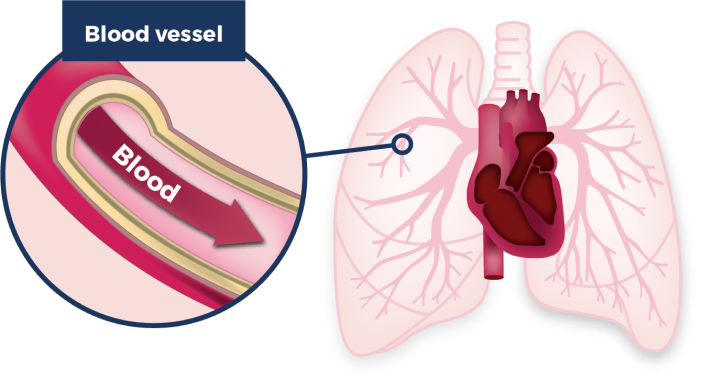
GETTING STARTED WITH WINREVAIR®

DETAILS FOR USING WINREVAIR®
Here’s some information that may be useful to help you get started.
As one of the first steps you may take on your journey, you and your doctor have decided on a treatment for pulmonary arterial hypertension (PAH). When you start anything new, you may face uncertainty about what’s coming next.
The goal of this site is to give you information and tools that can provide support as you go forward with your treatment.
Living with PAH means having regular discussions with your doctor, being an advocate for yourself, and really paying attention to how you’re feeling. Talking to your healthcare professional and taking an active role in your treatment can help you prepare for your treatment and managing PAH.
LEARN ABOUT YOUR TREATMENT
Here, you’ll find tools to use throughout your treatment with WINREVAIR®. Remember to check with your doctor if you have any questions.
WHAT IS WINREVAIR®?
WINREVAIR® is a prescription medicine to treat adults with PAH. PAH is a type of high blood pressure in the arteries of your lungs.
HOW DOES WINREVAIR® WORK?
THE LUNGS

WINREVAIR® is an activin receptor type IIA-Fc (ActRIIA-Fc) fusion protein that works to lower the blood pressure in your lung arteries.
Activin is a molecule involved in PAH, and it is found in the arteries of the lung.
![]() To learn more about how WINREVAIR® works, talk to your doctor.
To learn more about how WINREVAIR® works, talk to your doctor.
PAH=pulmonary arterial hypertension.
HOW TO TAKE WINREVAIR®
Your dosage
WINREVAIR® comes as a 45-mg or 60-mg solution for injection for subcutaneous use. Under the guidance of a healthcare professional, you and your caregiver may administer WINREVAIR® when considered appropriate and you have received training and follow-up from your healthcare professional on how to prepare, measure, and inject WINREVAIR®. Your dose of WINREVAIR® depends on your body weight and blood tests. There may be one or two 45-mg or 60-mg vials in the injection kit to receive your prescribed dose. Your doctor will tell you how much WINREVAIR® to take and when to take it. Do not change your dose or stop taking WINREVAIR® without talking to your healthcare professional. Do not take WINREVAIR® more often than your healthcare professional tells you to. If you are not sure when to take WINREVAIR®, call your healthcare professional.
Your doctor will monitor your dose:
- Before your first dose and regularly while taking WINREVAIR®, your doctor will do blood tests. These are done so that your doctor can monitor you and find the best dose for you.
- Your doctor may adjust your dose, delay treatment, or stop treatment depending on how you respond to WINREVAIR®.

Injecting WINREVAIR® (kit)
You will take WINREVAIR® every 3 weeks as an injection just under your skin (subcutaneous). It is important that you take WINREVAIR® exactly as your doctor tells you to.
STEP 1
Store
Store your full WINREVAIR® injection kit in the refrigerator until ready to mix. Remove your kit from the refrigerator 15 minutes before you are ready to prepare the mixture.
STEP 2
Mix
Mix the powdered medicine into liquid form, following your Instructions for Use booklet.
STEP 3
Inject
Administer your prescribed dose in your stomach at least 2 inches away from the belly button, or upper thigh, just under the skin (subcutaneously).
You should inject WINREVAIR® right away after mixing the medicine powder with the sterile water, but no later than 4 hours after mixing.
STEP 4
Dispose
Dispose of the used items in a sharps container.
Additional information
Self-injection is not appropriate for everyone. If your care team has agreed that you are eligible for self-injection, the above are the steps you will follow.
There are several steps involved in self-injection, which have not been detailed in full here. Please read the separate Instructions for Use booklet that comes with your kit each time you prepare and inject your dose.
Receiving WINREVAIR® (vial)
The single-use vial representation of WINREVAIR® is intended to be administered by a healthcare professional. You will be given WINREVAIR® every 3 weeks as an injection just under your skin (subcutaneous) in the stomach (abdomen) at least 2 inches away from the belly button, upper thigh, or upper arm.
For full instructions, you can also select the 1- or 2-vial kit to watch an instructional video on how to prepare WINREVAIR® for self-injection:
Refer to the Instructions for Use booklet in your product kit.
POSSIBLE SIDE EFFECTS
What are the possible side effects from using WINREVAIR®?
WINREVAIR® may cause side effects, but not everyone will experience them. It is important for you to be aware of them so that you can tell your doctor if needed.
These are not all the possible side effects you may have when taking WINREVAIR®. If you experience any side effects not listed here, tell your doctor.
The most common side effects of WINREVAIR® are:
- Nose bleeds (epistaxis)
- Telangiectasia (also called spider veins or tiny blood vessels that look like pink or red lines on the skin)
- Headache
- Diarrhea
In case of the following serious side effects, talk to your doctor.
Common
Symptom
Serious bleeding: Persistent headache, nausea, weakness, black or tarry stool, blood in your stool, bright red blood from vomiting or coughing, persistent abdominal cramps, severe back pain, or abnormally heavy menstrual bleeding.
These are more likely to happen if you take WINREVAIR® with certain medicines. Your doctor will tell you
how to recognize them.
What to do
Call your doctor.
Rare
Symptom
Erythrocytosis: A high level of hemoglobin (a protein in red blood cells that carries oxygen).
This can raise the chance of a blood clot forming that can block a blood vessel.
Severe thrombocytopenia: A low number of platelets (blood cells that help blood clot).
This may cause easy bruising, continued bleeding from cuts, and nosebleeds.
What to do
Call your doctor.
Your healthcare professional will do blood tests to check your hemoglobin levels before starting and regularly during treatment with WINREVAIR®.
Call your doctor.
Your healthcare professional will do blood tests to check your platelet level before starting and regularly during treatment with WINREVAIR®.
If you have a troublesome symptom or side effect that is not listed here or becomes bad enough to interfere with your daily activities, tell your doctor.
To help avoid side effects and ensure proper use, talk to your doctor before taking WINREVAIR®.
Talk about any health conditions you may have, including if you:
- Have or have had any medical conditions, and about any allergies.
- Are pregnant or if you are planning to get pregnant. WINREVAIR® may harm your unborn baby.
- Your doctor should do a pregnancy test before you start taking WINREVAIR®.
- You should use effective birth control when taking WINREVAIR®.
- You should continue using effective birth control for at least 4 months after your last dose if you stop taking WINREVAIR®. Ask your doctor about birth control methods that would work well for you.
- Become pregnant or think you may be pregnant while taking WINREVAIR®.
- Are breastfeeding or plan to breastfeed. It is not known if WINREVAIR® passes into breast milk.
- Do not breastfeed while taking WINREVAIR®.
- Do not breastfeed for at least 4 months after your last dose if you stop taking WINREVAIR®. Talk to your doctor about the best way to feed your baby.
Other warnings you should know about:
Fertility
- WINREVAIR® may decrease female and male fertility.
Children
- It is not known if WINREVAIR® is safe and effective in children under 18 years of age.
Tell your doctor about all the medicines you take, including any drugs, vitamins, minerals, natural supplements or alternative medicines. It is unknown if WINREVAIR® interacts with other medicines or supplements.
FREQUENTLY ASKED QUESTIONS
Here you may find some answers to common questions you may have about WINREVAIR®. Talk to your doctor about your PAH and any other questions you may have about WINREVAIR®.
Please see the patient information leaflet for WINREVAIR® for additional information.


What should I do if I am not sure I administered my prescription dose correctly?
Call your doctor if you are not sure that you have taken your WINREVAIR® properly.

What should I do if my kit parts are damaged or if the solution is cloudy, discoloured, or has particles?
Do not use your kit. Call your pharmacy to tell them you need a new kit.

What should I do if my kit is expired?
Do not use your kit. Call your pharmacy to tell them you need a new kit.

What should I do if my medicine does not turn clear after mixing?
Do not use the medicine if you have swirled the medicine vial and let it stand for another 3 minutes, but your medicine vial remains cloudy or has clumps, powder, or particles. Discuss with your healthcare professional.

Can I use my kit that has been left out of the refrigerator?
If the unused injection kit has been out of the refrigerator for an extended period of time, contact your doctor or pharmacist before proceeding.

Do I need to use mixed medicine right away?
It is recommended that you inject the medicine right away after mixing but no later than 4 hours after mixing. If it has been more than 4 hours, throw away the unused mixed medicine.

How do I store WINREVAIR®?
Store WINREVAIR® in the refrigerator at 2°C to 8°C. Do not freeze. Store in the original container to help protect from light. Contact your doctor or pharmacist if the unused injection kit has been out of the refrigerator for an extended period of time. After you mix the medicine powder with the sterile water (provided in the kit), it is recommended that you inject it right away. Keep out of reach and sight of children.

What do I do if I miss a dose?
If you self-inject WINREVAIR® and miss your prescribed dose, take it within 3 days and follow your original schedule for your next dose. If not taken within 3 days, call your doctor for guidance.
If you miss your appointment to be given WINREVAIR®, call your healthcare professional immediately to reschedule your appointment.

What if I have taken more than my prescribed dose of WINREVAIR®?
If you think you, or a person you are caring for, have taken too much WINREVAIR®, contact a doctor, hospital emergency department, or regional poison control centre immediately, even if there are no symptoms.
PAH=pulmonary arterial hypertension.
RESOURCES
Find support with other Canadians living with PAH
Visit the Pulmonary Hypertension Association of Canada for resources, support, and the latest information on PAH.
Visit the Fondation HTAPQ to access support services, educational materials, and patient communities.
Need additional support?
Contact a representative from Merck CareTM Integrate Patient Support Program by calling 1-888-959-3947 Monday to Friday, 9 AM to 5 PM (ET), via email (info@merckcareintegrate.com), or by fax (1-877-658-2135).
PAH=pulmonary arterial hypertension.
